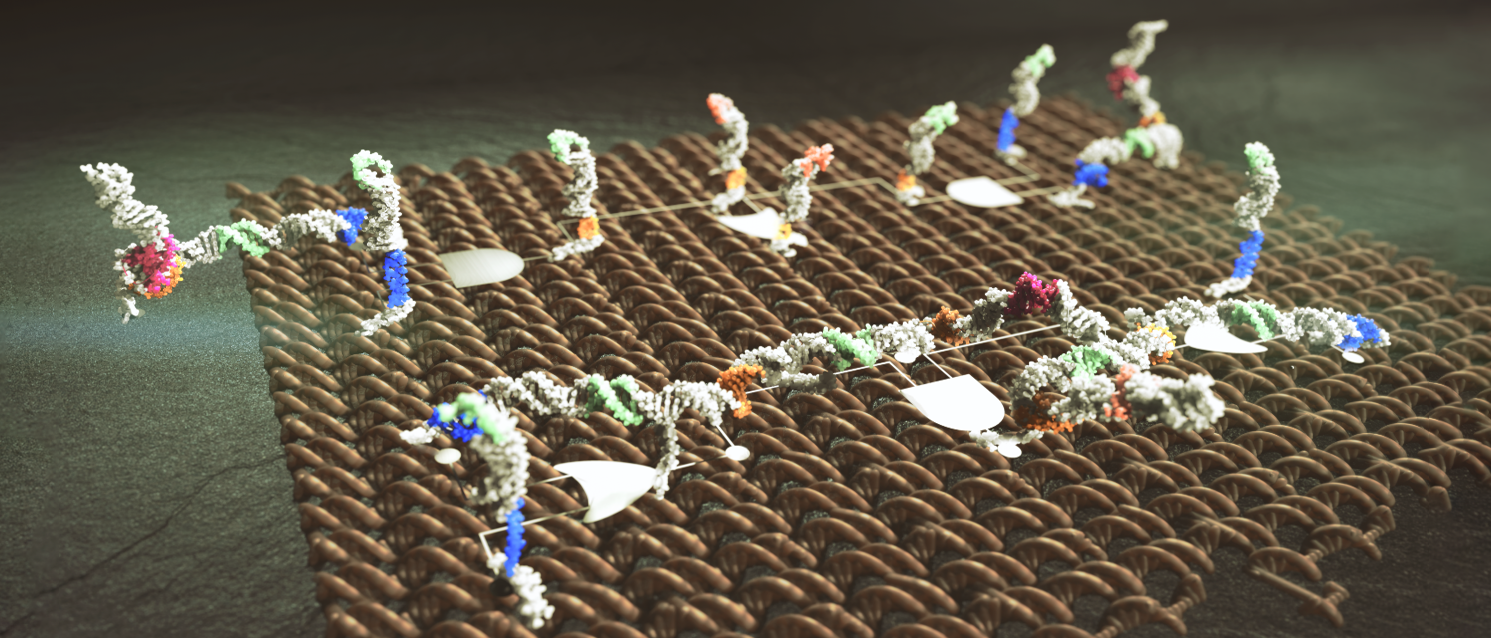
By Microsoft Research
Human-engineered systems, from ancient irrigation networks to modern semiconductor circuitry, rely on spatial organization to guide the flow of materials and information. Living cells also use spatial organization to control and accelerate the transmission of molecular signals, for example by co-localizing the components of enzyme cascades and signaling networks. In a new paper published today by the journal Nature Nanotechnology, scientists at the University of Washington and Microsoft Research describe a method that uses spatial organization to build nanoscale computational circuits made of synthetic DNA. Called “DNA domino” circuits, they consist of DNA “domino” molecules that are positioned at regular intervals on a DNA surface. Information is transmitted when DNA dominoes interact with their immediate neighbors in a cascade.
Spotlight: Microsoft research newsletter
For decades, scientists in the field of molecular programming have been studying how to use DNA molecules to compute. This includes developing algorithms that operate effectively at the molecular scale, and identifying fundamental principles of molecular computation. The components of these molecular devices are typically made from strands of synthetic DNA, where the sequence of the strands determines how they interact. Real-world applications of these devices could in the future include in vitro diagnostics of pathogens, biomanufacturing of materials, smart therapeutics and high-precision methods for imaging and probing biological experiments. So far, however, most of these devices have been designed to operate in a chemical soup, where billions of DNA molecules rely on the relatively slow process of random diffusion to bump into each other and execute a computational step. This limits the speed of the computation and the number of different components that can effectively be used. This is because the freely diffusing DNA molecules can collide with each other at random, so they must be carefully designed to avoid unintended computations when these random collisions occur.
DNA domino circuits represent an important advance. They were developed through a collaboration between Georg Seelig’s lab at the University of Washington in Seattle and Andrew Phillips’s Biological Computation group at Microsoft Research. Since DNA dominoes are positioned close to each other on a surface, they can quickly interact with their immediate neighbors without relying on random diffusion for each computational step. This can lead to an order of magnitude increase in speed compared to circuits where all the components are freely diffusing. In addition, DNA dominoes can be re-used in multiple locations with almost no interference since their physical location, in addition to their chemical specificity, determines what interactions can and cannot take place.
The scaffold that secures the DNA dominoes is assembled from hundreds of DNA strands using a technique called DNA origami that was first described in 2006. A long single strand of DNA, called the scaffold, is pinned into a rectangular shape by shorter DNA strands called staples. To build a nanoscale computational circuit on a DNA origami surface, individual DNA dominoes are incorporated into the origami during the folding process using special types of elongated staples. Each of these staples is precisely positioned on the same side of the origami scaffold, and folds over into a hairpin shape to form a DNA domino (see figure).
The researchers used this precise positioning to layout the DNA dominoes into signal transmission lines, similar to lines of real dominoes, and elementary Boolean logic gates that compute the logical AND and OR of two inputs. By linking these elementary gates together, the researchers created more complex circuits such as a two-input dual-rail XNOR circuit (see figure), which can in principle be used as the building block for a molecular computer. Freely diffusing DNA strands act as inputs to the circuits, while a single type of DNA fuel strand powers the transmission of signals between neighboring DNA dominoes. The researchers constructed detailed computational models of their designs and used extensive experimental measurements to identify the model parameters and quantify their uncertainty. This modeling allowed the researchers to accurately predict the behavior of more complex circuits, speeding up the design process.
This new approach lays the groundwork for using spatial constraints in molecular engineering more broadly and could help bring embedded molecular control circuits closer to practical applications in biosensing, nanomaterial assembly and therapeutic DNA robots.
Related:
- Learn more about the Biological Computation group at Microsoft Research
- A spatially localized architecture for fast and modular DNA computing
- Seelig Quantitative Biology and DNA Nanotechnology Lab
- Programming DNA
The research was funded by the National Science Foundation, Office of Naval Research and Microsoft Research.
The paper, “A spatially localized architecture for fast and modular DNA computing,” was published on Nature Nanotechnology’s website on July 24, 2017, and will appear at a later date in the print issue of the journal. In addition to Phillips and Seelig, co-authors are Gourab Chatterjee, a doctoral student at the University of Washington, Richard Muscat, formerly a postdoctoral associate at the University of Washington and currently at Cancer Research UK, and Neil Dalchau of Microsoft Research.





